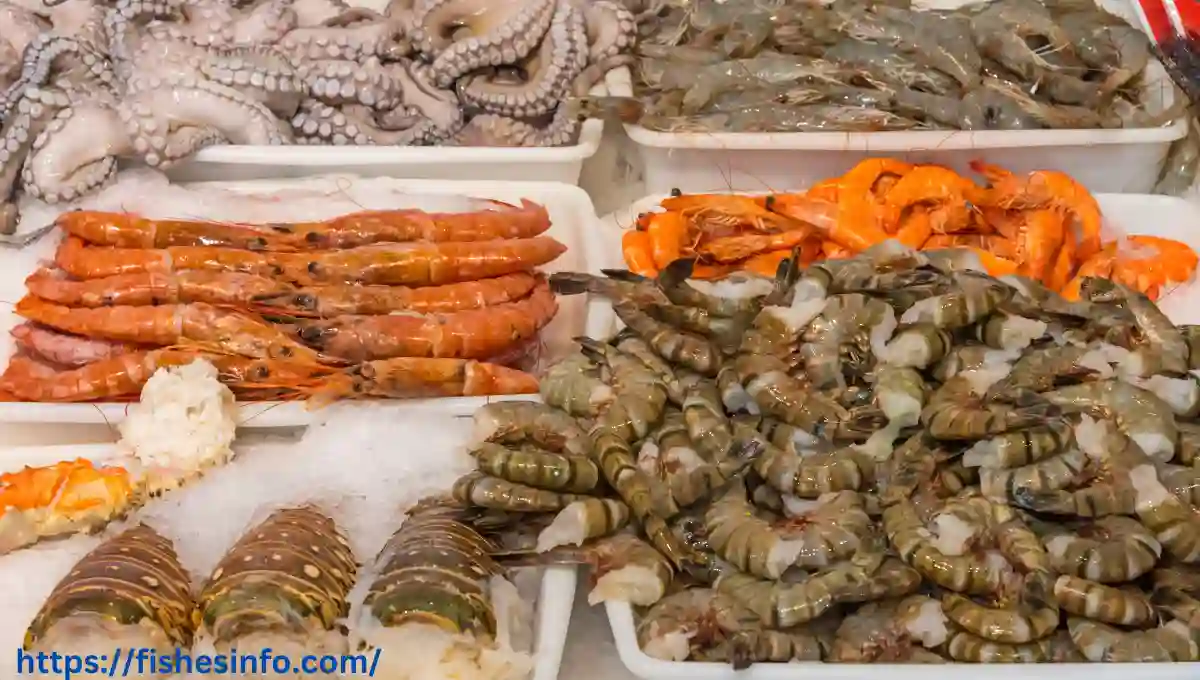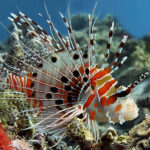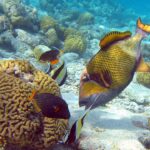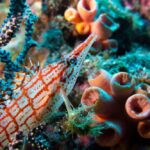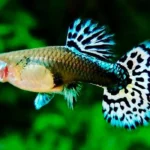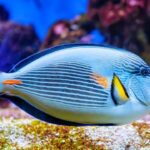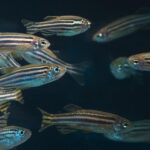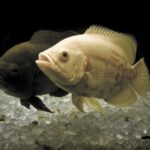Crustaceans are distinguished by their strong exoskeletons and two pairs of antennae. Humans commonly eat them worldwide, with prominent examples being crabs, lobsters, shrimp (or prawns), and crayfish.
Other lesser-known types include barnacles, water fleas, and pill bugs. All these are the members of the arthropod group, which also includes insects and spiders. This article explains all the information about this creature along with general Characteristics.
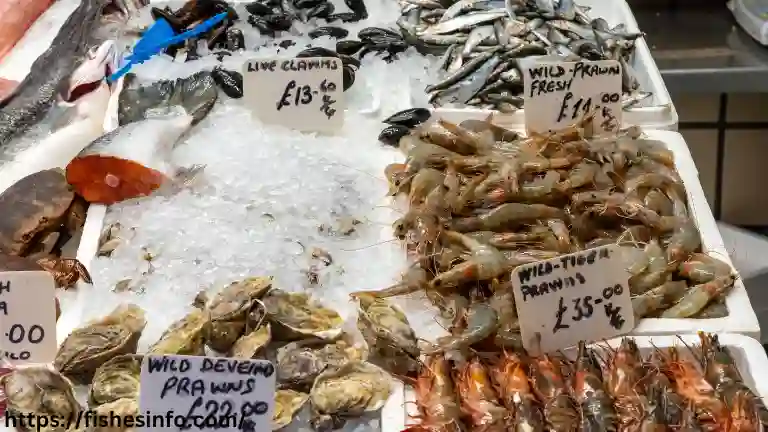
What are Crustaceans?
Crustaceans are a varied group of invertebrate organisms belonging to the phylum Arthropoda and subphylum Crustacea. They include common species such as barnacles, crabs, crayfish, lobsters, shrimp, water fleas, and pill bugs.
While most are aquatic, certain species may be found in terrestrial settings. Of the roughly 40,000 species of aquatic crustaceans, only about 10% exist in freshwater habitats.
They have developed a vast diversity of body shapes and behaviors to adapt to their habitats, whether aquatic or terrestrial. Despite this variety, they have some characteristics: a hard exoskeleton, jointed and paired limbs, and three primary body regions—head, thorax, and belly. In certain species, the head and thorax are united into a single structure termed the cephalothorax.
Where do Crustaceans live?
Crustaceans dwell in a range of settings, typically aquatic conditions. They may be found in oceans, seas, rivers, lakes, and even in brackish water (water that is saltier than freshwater but not as salty as saltwater). Some are suited to life in terrestrial habitats, such as on land, in humid places like woods, or even in deserts. They are very varied and may fill practically any niche within their aquatic or terrestrial environments.
Crustaceans List
Here is a list of 50 crustaceans:
- American lobster
- European lobster
- Norway lobster (langoustine)
- Common shrimp
- Rock shrimp
- Tiger shrimp
- White leg shrimp
- Pink shrimp
- Blue shrimp
- Brown shrimp
- Northern shrimp
- Glass shrimp
- Humpback shrimp
- Peppermint shrimp
- Mantis shrimp
- Spiny lobster
- Slipper lobster
- Fiddler crab
- Ghost crab
- Red king crab
- Blue king crab
- Dungeness crab
- Snow crab
- Stone crab
- Hermit crab
- Coconut crab
- Porcelain crab
- Arrow crab
- Spider crab
- Decorator crab
- Box crab
- Blue swimmer crab
- Chinese mitten crab
- Japanese spider crab
- Pea crab
- Velvet crab
- European green crab
- Jonah crab
- Gulf stone crab
- Dardanus megistos (strawberry hermit crab)
- Lysiosquillina maculata (stomatopod)
- Squilla mantis (mantis shrimp)
- Oratosquilla oratorio (mantis shrimp)
- Alpheus randalli (pistol shrimp)
- Calcinus laevimanus (hermit crab)
- Atya gabonensis (fan shrimp)
- Periclimenes amethysts (anemone shrimp)
- Lysmata Sebelius (scarlet cleaner shrimp)
- Hippolyte ventricosa (seagrass shrimp)
- Lebbeus grandimanus (thumb-splitter shrimp)
This list includes a variety from common species like shrimp and crabs to more exotic species like the coconut crab and mantis shrimp.
Body Structure
- Segmentation: The body is composed of segments grouped into three regions: cephalon (head), pereon (thorax), and pleon (abdomen).
- Cephalothorax: The head and thorax may fuse to form a cephalothorax, often covered by a single large carapace.
- Exoskeleton: The hard exoskeleton protects the body and must be molted for growth.
- Segment Structure: Each somite has a dorsal tergum, ventral sternum, and lateral pleuron; parts of the exoskeleton may be fused.
- Appendages: Each body segment can bear a pair of appendages; head segments have antennae, mandibles, and maxillae; thoracic segments bear legs, specialized as pereiopods (walking legs) and maxillipeds (feeding legs).
- Abdominal Appendages: Malacostraca and Remipedia (and hexapods) have abdominal appendages; others have limbless abdomens, except for a telson and caudal rami.
- Abdominal Structure: The abdomen in malacostracans bears pleopods, ending in a telson with an anus, often flanked by uropods to form a tail fan.
Appendage Characteristics
- Biramous Appendages: Typically, appendages are biramous (divided into two parts), except for the first pair of antennae, usually uniramous.
- Evolutionary State: It is uncertain if the biramous condition is a derived state in crustaceans or if the second branch of the limb has been lost in other groups.
- Comparison to Trilobites: Trilobites also had biramous appendages.
Circulatory and Digestive Systems
- Open Circulatory System: Blood is pumped into the hemocoel by a heart near the dorsum.
- Respiratory Pigments: Malacostraca has hemocyanin, while copepods, ostracods, barnacles, and branchiopods have hemoglobins.
- Alimentary Canal: Consists of a straight tube with a gizzard-like “gastric mill” for grinding food and digestive glands for absorption; spiral format.
- Kidney Structures: Structures functioning as kidneys are located near the antennae.
- Nervous System: A brain in the form of ganglia is close to the antennae, with major ganglia found below the gut.
Reproduction and Mating
Most aquatic animals have separate sexes and reproduce sexually. Male T. californicus prefers algae-fed females over yeast-fed ones, while some hermaphrodites, barnacles, remipedes, and Cephalocarida may change sex.
Parthenogenesis, where viable eggs are produced by a female without male fertilization, is widespread in many sea creature, including branchiopods, ostracods, isopods, and certain higher crustaceans.
- Pleopod Specialization: In many decapods, the first (and sometimes second) pair of pleopods are specialized in males for sperm transfer.
- Seasonal Mating: Many terrestrial arthropods mate seasonally and return to the sea to release eggs; others lay eggs on land in damp conditions.
- Egg Retention: Most decapod females retain eggs until they hatch into free-swimming larvae. Many release fertilized eggs into the water column, while others have mechanisms to hold them until hatching.
Decapods carry eggs attached to the pleopods, while peracarids, notostracans, anostracans, and isopods form a brood pouch. Female Branchiura attaches eggs to rocks and objects. Leptostracans and krill carry eggs between thoracic limbs, while copepods have eggs in thin-walled sacs or tangled strings.
Classification of Crustaceans
Here is an expanded table including all classes of this arthropod discovered so far:
| Class | Subclass | Order | Examples |
|---|---|---|---|
| Malacostraca | Eumalacostraca | Decapoda | Crabs, lobsters, shrimp |
| Amphipoda | Sand hoppers, beach fleas | ||
| Peracarida | Isopoda | Woodlice, pill bugs | |
| Branchiopoda | Anostraca | Fairy shrimp | |
| Diplostraca | Water fleas, clam shrimp | ||
| Maxillopoda | Thecostraca | Cirripedia | Barnacles |
| Ostracoda | Podocopida | Seed shrimp | |
| Myodocopa | Mussel shrimp | ||
| Copepoda | Planktonic copepods | ||
| Remipedia | Remipedia | Remipedes | |
| —————– | ————————- | ——————— | ——————————— |
| Branchiura | Fish lice | ||
| Pentastomida | Tongue worms | ||
| Tantulocarida | Tantulus | ||
| Cephalocarida | Horseshoe shrimp |
Please note that this table may not include very recently discovered or debated classes, and some classifications may vary based on different taxonomic sources.

General Characteristics
Size Range and Diversity
- The largest crustaceans belong to the Decapoda, which includes about 10,000 species.
- The American lobster, a Decapod, can reach a weight of 20 kilograms (44 pounds).
- The giant Japanese spider crab, another Decapod, has legs that can span up to 3.7 meters (12 feet).
- Some water fleas (class Branchiopoda), like Alonella, are less than 0.25 millimeters (0.009 inch) long.
- Many members of the subclass Copepoda are less than one millimeter in length.
- The diverse structures of such sea creatures are reflected in their complex classification.
- Some parasitic forms are so modified and specialized as adults that they are recognized as crustaceans only by features of their life histories.
Abundance and Distribution in Nature
- Crustaceans are primarily aquatic, inhabiting freshwater, seawater, and highly saline inland brines.
- They occupy various aquatic niches, from free-swimming planktonic species in open waters to bottom-dwelling species that crawl or burrow into sediment.
- They are found in rocky, sandy, and muddy areas, with some species living between sand grains or in seaweed fronds.
- Species from the orders Isopoda and Amphipoda are found at extreme ocean depths, including oceanic trenches up to 10,000 meters deep.
- They can be found in lakes and rivers worldwide, even at high altitudes like 5,000 meters in mountain lakes.
- Some crabs, like ghost crabs and mangrove crabs, are amphibious and can scavenge on land. Others, known as land crabs, must return to water for their larvae to hatch.
- Woodlice (order Isopoda, family Oniscoidea) are the most terrestrial crustaceans, living in damp places, with some species surviving in deserts.
- Other crustaceans, such as amphipods, copepods, ostracods, and members of the order Anomopoda, have been found in damp forest leaf litter, showing some adaptation to a semi-terrestrial lifestyle.
Internal Body Structure
The Nervous System
The neurological system of these aquatic animals contains a brain, or supraesophageal ganglion, coupled to a ventral nerve cord comprising ganglia, or nerve centers. In lower species like fairy shrimps, the brain links to the eyes and antennules, while the nerves to the antennae originate from a ring around the esophagus. In more advanced versions, the antennal nerves originate in the brain.
The first ventral nerve center beneath the esophagus is normally created by the union of ganglia from the mandibular, maxillary, and maxillary segments, with additional ganglia sometimes involved. Often, there is a chain of ganglia down the trunk, but in short-bodied species like barnacles and crabs, all ventral ganglia may unite into a single mass during growth.
The most prominent sensory organs are the compound eyes, comparable to those of flies and insects. Each eye in a decapod consists of several hundred tubular units emanating from an optic nerve. Each unit is a small eye, with a central optical tract segregated by pigment cells.
These cells may stretch and contract to cover various portions of each tubular eye, enabling the eyes to operate under changing light levels. While the picture acquired with such an eye is patchwork, advanced crabs demonstrate behavior showing they receive a clean image and can detect little movements. They also have single median eyes, notably in nauplius larvae.
These eyes normally have just three or four basic units and are attached to a nerve from the forebrain. Some copepods depend entirely on the median eye, which may survive even after complex eyes develop.
Crustaceans also sense physical and chemical stimuli via setae, or hairlike structures, on their exoskeletons. Some setae are tactile, sensing touch and movement, while others are employed with statocysts, which aid with orientation to gravity.
Statocysts are paired organs holding microscopic granules called statoliths, which rest on setae. Changes in orientation cause the statoliths to push on the setae at varying angles, notifying the brain for corrective action. Some setae are chemosensory, sensing different chemical compounds, and are commonly plentiful on antennules and mouthparts.
Digestive System
The digestive system of crustaceans is mainly a straight conduit through the body, with just a few water fleas possessing a coiled stomach. The foregut varies widely in construction; in some species, it is a simple tube, while in decapods, it forms a complicated structure known as the gastric mill.
This mill comprises calcified plates, or ossicles, that are pushed against one another by powerful muscles, providing an effective grinding device. A filter of setae protects the intersection between the mill and the midgut, keeping particles from entering the midgut until they are tiny enough.
The midgut’s anatomy varies but often contains one or more pouches, or diverticula, involved in digesting. These diverticula might be simple or complicated and glandular. The hindgut is normally short and coated by cuticle, and its departure is regulated by a muscular anus, which in certain species possesses dilator muscles that govern anal swallowing.
Excretory System
Crustaceans have two primary excretory organs: the antennal gland and the maxillary gland. Both organs have a similar anatomy, consisting of an end sac and a convoluted duct that may grow into a bladder before opening to the outside. Typically, only one of these glands operates in adult ones, and the functional gland may vary over the life cycle.
The fundamental job of the antennal and maxillary glands is to control ionic equilibrium. These glands also play a function in managing the overall balance of salts and water in the body. Additionally, the antennal gland has been proven to reabsorb glucose. They generally excrete the result of nitrogen metabolism, which is ammonia, via their gills.
However, certain terrestrial crabs create urea or uric acid instead of ammonia, since these molecules are less poisonous. Urea and uric acid may be retained in specific big cells at the bases of the legs or expelled without severe water loss.
Respiratory System
Many smaller crustaceans, like copepods, do not have specialized respiratory organs. Instead, gas exchange occurs through their thin skin. The inner wall of the carapace, facing the body, is often rich in blood vessels and may serve as the main respiratory organ in many groups. Gills, if present, are formed from modified parts of appendages, usually the epipodites.
These thin, lamellate structures can be found on some or all of the thoracic appendages in cephalocarids, fairy shrimps, and many malacostracans. For example, mantis shrimps have gills on the exopodites of their pleopods. Euphausiids have branched epipodial gills that are fully exposed.
Decapods have gills arranged in three series near the bases of their limbs, protected by the carapace. Some land crabs have enlarged branchial chambers that serve as lungs, with the inner membrane rich in blood vessels for aerial respiration.
Isopods have a respiratory function in their abdominal appendages, with either rami or the endopodite becoming thin and flattened. Additionally, many sow bugs and pill bugs have trachea-like structures in some of their exopodites.
Circulatory System
Like other arthropods, They have blood that runs in sinuses or channels without distinct walls. Some, like cirripedes, ostracods, and copepods, do not have a heart. Instead, their blood is maintained flowing by a blood pump or rhythmic body, stomach, or appendage motions.
When a heart is present, it resides in a blood sinus called a pericardium, interacting with it via paired valvular holes called ostia. In more primitive crustaceans, such as fairy shrimps or stomatopods, the heart is a long tube with spiral muscles in its wall, running virtually the entire length of the stem.
There is a pair of Ostia in each somite save the final. In more mature crustaceans, the heart may be shorter, with fewer than three pairs of ostia. The heart’s position depends on the placement of the respiratory organs, commonly in the thorax or cephalothorax but largely in the abdomen of isopods. Malacostracans have a well-developed system of elastic-walled arteries, comprising an anterior and generally a posterior aorta.
The red respiratory pigment hemoglobin has been detected in the blood of branchiopods and other groups save Malacostraca. Malacostracan decapods and stomatopods have hemocyanin, a respiratory pigment containing copper instead of iron, in their blood.
Crustaceans’ Role in Ecosystem
They are vital species in nature because they help maintain the ecosystem balance. They devour dead plants and animals, which helps clean up the water. Some also devour smaller creatures, which helps limit their number.
Crustaceans themselves provide food for larger creatures like Fish and birds, therefore they are an essential element of the food chain. Some forms of crustaceans, like crabs and shrimp, create shelters for themselves that offer refuge for other creatures too.
By living in diverse habitats and responding to changes in their environment, they can indicate to us whether an ecosystem is healthy or if there are issues that need to be solved.
Frequently Asked Questions (FAQ)
What do Crustaceans mean?
Crustaceans are a group of arthropods that include animals like crabs, lobsters, shrimp, and barnacles. They are characterized by having a hard exoskeleton, jointed limbs, and a segmented body.
Are lobsters considered crustaceans?
Yes, lobsters are considered crustaceans. They belong to the order Decapoda, which also includes crabs, shrimp, and crayfish. Lobsters are defined by their hard exoskeleton, jointed limbs, and segmented bodies, all of which are characteristic traits of crustaceans.
What type of animal is a Crustaceans?
Crustaceans are a form of arthropod, which is a category of invertebrate creatures having exoskeletons, segmented bodies, and jointed limbs. Other arthropods include insects, spiders, and centipedes.
What are the 5 characteristics of Crustaceans?
Exoskeleton: Crustaceans have a hard outer covering called an exoskeleton that provides protection and support for their bodies.
Jointed Appendages: They have jointed limbs that are used for walking, swimming, and capturing food.
Segmented Body: They have a body that is divided into segments, including a distinct head, thorax, and abdomen in many species.
Gills: Most crustaceans have gills that allow them to extract oxygen from water.
Molting: They undergo molting, where they shed their old exoskeleton and grow a new one to accommodate their increasing size.
Are Crustacean fish?
No, crustaceans are not fish. Fish are vertebrates that belong to the class Osteichthyes or Chondrichthyes, while they are invertebrates belonging to the class Crustacea.
What are the most common crustaceans?
The most common include:
Shrimp: Found in both freshwater and saltwater, shrimp are popular in many cuisines worldwide.
Crabs: Crabs are found in various aquatic environments and are known for their sideways movement.
Lobsters: Lobsters are large crustaceans found in cold, deep waters and are prized for their meat.
Barnacles: These attach themselves to hard surfaces such as rocks and ships’ hulls.
Crawfish: Also known as crayfish or crawdads, these freshwater crustaceans are popular in Southern cuisine.
These are just a few examples of the most common crustaceans, but there are many other species found in various habitats around the world.
Are any bus Crustaceans?
No, buses are not crustaceans. Buses are large vehicles used for public transportation, while they are a group of arthropods that include animals like crabs, lobsters, shrimp, and barnacles.
What is the largest known Crustacean?
The largest known crustacean is the Japanese spider crab (Macrocheira kaempferi). These crabs can have a leg span of up to 3.7 meters (12 feet) and can weigh up to 19 kilograms (42 pounds). They are found in the waters around Japan and are known for their long, spindly legs and large body size.
Which is the Smallest Known Crustacean?
The smallest known crustacean is the species Stygotantulus stocki, a tiny copepod that measures only about 94 micrometres in length. This tiny crustacean was discovered in a groundwater habitat in Western Australia.
Are Scallops Crustaceans?
No, scallops are not crustaceans. Scallops are bivalve molluscs, belonging to the family Pectinidae. They are notable for their fan-shaped shells and are a favourite seafood dish. Crustaceans, on the other hand, are a category of arthropods that include creatures like crabs, lobsters, shrimp, and barnacles.
What is the rare Crustacean species?
One unusual crustacean species is the “Troglocaris anophthalmus,” a blind cave-dwelling shrimp discovered in the subterranean waters of the Dinaric karst caverns in the Balkans. Another unusual species is the “Kiwa hirsuta,” a hairy-chested yeti crab found near hydrothermal vents in the Pacific Ocean. These species are uncommon owing to their specialized habitat needs and restricted range.
Which animal is not a Crustacean?
An animal that is not a crustacean is a jellyfish. Jellyfish belong to the phylum Cnidaria, whereas crustaceans belong to the phylum Arthropoda. Jellyfish are classed as invertebrates, however, they are not closely related to crustaceans, which include creatures like crabs, lobsters, shrimp, and barnacles.
What is the only venomous Crustacean?
The only poisonous crustacean is the remipede, especially the species of the genus Xibalbanus. Remipedes are tiny, blind, and cave-dwelling crustaceans found in underwater caverns. They feature poisonous claws that they utilize to grab and paralyze their food, which consists mostly of tiny aquatic invertebrates.
What is the oldest crustacean ever found?
The oldest crustacean fossils ever found date back to the Cambrian Period, around 500 million years ago. These fossils belong to primitive crustaceans that lived in ancient seas. One example is the Burgess Shale fossil site in Canada, which has preserved a variety of early crustaceans and other marine organisms from the Cambrian Period.
What was the first crustacean on earth?
The first crustaceans on Earth appeared during the Cambrian Period, which began around 541 million years ago. These early crustaceans were likely primitive forms that resembled modern-day crustaceans but may have had simpler body structures. Fossils of some of these early animals have been found in ancient rock formations, providing clues about their appearance and evolution over time.
What is the only crustacean that lives on Land?
The only crustacean that is known to live exclusively on land is the terrestrial hermit crab (Coenobita spp.). These crabs are found in tropical and subtropical regions and have adapted to terrestrial life by developing specialized gills that allow them to breathe air. They are commonly found in coastal areas, where they inhabit burrows and feed on plant matter and decaying organic material.
Can Crustacean Feel Pain?
The subject of whether crustaceans can experience pain is a matter of scientific discussion. While crustaceans have a nervous system and may demonstrate reactions to damaging stimuli, it is uncertain whether they feel pain in the same way that humans and other animals do. Some studies imply that they may have nociception, which is the capacity to perceive noxious stimuli, however, this does not necessarily reflect the sensation of pain as humans understand it. Further study is required to completely grasp the potential for pain perception in crustaceans.
Is a Horseshoe Crab a Crustacean?
Yes, a horseshoe crab is a crustacean. Despite its name, the horseshoe crab is more closely related to spiders and scorpions than to true crabs. Horseshoe crabs are ancient marine arthropods that have remained relatively unchanged for millions of years. They are classified in the subphylum Chelicerata, along with arachnids, and are not considered true crabs, which belong to the class Malacostraca within the subphylum Crustacea.
Conclusion
Crustaceans are intriguing organisms that play crucial roles in marine and aquatic environments. From the tiniest copepod to the biggest Japanese spider crab, these varied organisms demonstrate a broad variety of adaptations and behaviors.
While some, like lobsters and shrimp, are appreciated as seafood, others, such as barnacles and krill, provide the basis of marine food webs. Despite their ecological significance, many crab species suffer risks from habitat degradation, pollution, and exploitation.
We must continue researching and safeguarding these rare species to guarantee their existence for future generations to appreciate and wonder at.
